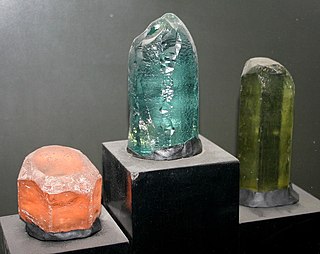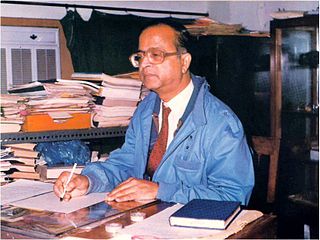Related Research Articles

Amethyst is a violet variety of quartz. The name comes from the Koine Greek αμέθυστος amethystos from α- a-, "not" and μεθύσκω methysko / μεθώ metho, "intoxicate", a reference to the belief that the stone protected its owner from drunkenness. Ancient Greeks wore amethyst and carved drinking vessels from it in the belief that it would prevent intoxication.

Beryl ( BERR-əl) is a mineral composed of beryllium aluminium silicate with the chemical formula Be3Al2Si6O18. Well-known varieties of beryl include emerald and aquamarine. Naturally occurring, hexagonal crystals of beryl can be up to several meters in size, but terminated crystals are relatively rare. Pure beryl is colorless, but it is frequently tinted by impurities; possible colors are green, blue, yellow, pink, and red (the rarest). It is an ore source of beryllium.

Chandragupta Maurya was the founder of the Maurya Empire, a geographically-extensive empire based in Magadha. He reigned from 320 BCE to 298 BCE. The Magadha kingdom expanded to become an empire that reached its peak under the reign of his grandson, Ashoka the Great, from 268 BCE to 231 BCE. The nature of the political formation that existed in Chandragupta's time is not certain. The Mauryan empire was a loose-knit one with large autonomous regions within its limits.
Shudra or Shoodra is the bottom varna of the four varnas of the Hindu varna system and social order in ancient India. Some sources translate it into English as a caste, or alternatively as a social class. Theoretically, Shudras constituted a class like employees.
Shastra is a Sanskrit word that means "precept, rules, manual, compendium, book or treatise" in a general sense. The word is generally used as a suffix in the Indian literature context, for technical or specialized knowledge in a defined area of practice.

Chanakya was an ancient Indian polymath who was active as a teacher, author, strategist, philosopher, economist, jurist, and royal advisor. He is traditionally identified as Kauṭilya or Vishnugupta, who authored the ancient Indian political treatise, the Arthashastra, a text dated to roughly between the fourth century BCE and the third century CE. As such, he is considered the pioneer of the field of political science and economics in India, and his work is thought of as an important precursor to classical economics. His works were lost near the end of the Gupta Empire in the sixth century CE and not rediscovered until the early 20th century. Around 321 BCE, Chanakya assisted the first Mauryan emperor Chandragupta in his rise to power and is widely credited for having played an important role in the establishment of the Maurya Empire. Chanakya served as the chief advisor to both emperors Chandragupta and his son Bindusara.

The Maurya Empire was a geographically extensive Iron Age historical power in South Asia based in Magadha. Founded by Chandragupta Maurya in 322 BCE, it existed in loose-knit fashion until 185 BCE. The empire was centralized by the conquest of the Indo-Gangetic Plain; its capital city was located at Pataliputra. Outside this imperial centre, the empire's geographical extent was dependent on the loyalty of military commanders who controlled the armed cities scattered within it. During Ashoka's rule the empire briefly controlled the major urban hubs and arteries of the Indian subcontinent excepting the deep south. It declined for about 50 years after Ashoka's rule, and dissolved in 185 BCE with the assassination of Brihadratha by Pushyamitra Shunga and foundation of the Shunga dynasty in Magadha.
The Arthashastra is an Ancient Indian Sanskrit treatise on statecraft, political science, economic policy and military strategy. Kautilya, also identified as Vishnugupta and Chanakya, is traditionally credited as the author of the text. The latter was a scholar at Takshashila, the teacher and guardian of Mauryan emperor Chandragupta Maurya. Some scholars believe them to be the same person, while a few have questioned this identification. The text is likely the work of several authors over centuries. Composed, expanded and redacted between the 2nd century BCE and 3rd century CE, the Arthashastra was influential until the 12th century, when it disappeared. It was rediscovered in 1905 by R. Shamasastry, who published it in 1909. The first English translation, also by Shamasastry, was published in 1915. After a dormant reception, primarily confined to the academic circles, the conversation around Arthashastra in 21st century has generated sudden global interest, especially amongst global power-predictors, who are trying to decipher what a rising India would mean for the world, as it is anticipated to reflect the indigenous model of Shakti as defined by Kautilya Arthashastra. It has a unique approach to defining Power of the nation states.

The Yadava were an ancient Indian people who believed to be descended from Yadu, a legendary king of Chandravamsha lineage.

Pandurang Vaman Kane was an Indian academic, historian, lawyer, Indologist, and Sanskrit scholar. He was awarded the Bharat Ratna, India's highest civilian award in 1963.

Navaratna is a Sanskrit compound word meaning "nine gems" or "ratnas". Jewellery created in this style has important cultural significance in many southern, and south-eastern Asian cultures as a symbol of wealth, status, and is claimed to yield talismanic benefits towards health and wellbeing. The setting of the stones is believed to hold mystical powers tied to the astrology and mythology of Hinduism, Jainism and Buddhism. The historic origin of the navaratna is tied to the astrological concept of "Navagrahas", or "nine celestial gods" (planets).

Shilpa Shastras literally means the Science of Shilpa. It is an ancient umbrella term for numerous Hindu texts that describe arts, crafts, and their design rules, principles and standards. In the context of Hindu temple architecture and sculpture, Shilpa Shastras were manuals for sculpture and Hindu iconography, prescribing among other things, the proportions of a sculptured figure, composition, principles, meaning, as well as rules of architecture.
Indian political philosophy is the branch of philosophical thought in India that addresses questions related to polity, statecraft, justice, law and the legitimacy of forms of governance. It also deals with the scope of religion in state-organization and addresses the legitimacy of sociopolitical institutions in a polity. Political thought in India has a history of more than two millennia from the late Iron Age to Modernity and has influenced the socioreligious systems of Asia tremendously in the lieu of Hindu, Buddhist & Jain political philosophy.

Gauda, was a territory located in Bengal in ancient and medieval times, as part of the Gauda Kingdom.
Rudrapatna Shamasastry FRAS (1868–1944) was a Sanskrit scholar and librarian at the Oriental Research Institute Mysore. He re-discovered and published the Arthashastra, an ancient Indian treatise on statecraft, economic policy, and military strategy.

Kamarupa Pithas are ancient pithas or geographical divisions of Kamarupa. The division of the Pithas are not consistent in different sources, though the number of pithas are usually four. Since these pithas are not mentioned in the Kamarupa inscriptions, and are found mentioned only in later medieval texts some authors have suggested that these divisions are possible later fabrications. The Yogini Tantra, mentions the Kamarupa Pithas, the same work which gives boundaries of ancient Kamrup kingdom as well.

Arun Kumar Biswas was a professor at Indian Institute of Technology, Kanpur (India) during 1963–95. He is well known for his contributions in the area of mineral engineering, archaeometallurgy, minerals and gems in antiquity, history of science, philosophy, science and music, etc. Biswas was the founding member of Indian Institute of Mineral Engineers (1969). Founder president of Indian Language Society in the early 1980s at IIT/K, he served several organizations in various honorary capacities: Mahendralal Sircar Research Professor in History of Science at the Asiatic Society, Kolkata (1995–2001); the AICTE Emeritus Fellow at the Jadavpur University (2001–2004); and INSA Research Fellow in Kolkata. He was a member of the INSA National Commission for History of Science and, the editorial board member of the Indian Journal of the History of Science.
Nitisara or the Nitisara of Kamandaki, is an ancient Indian treatise on politics and statecraft. It was authored by Kamandaka, also known as Kamandaki or Kamandakiya, who was a disciple of Chanakya. It is traditionally dated to the 4th-3rd century BCE, though modern scholarship variously dates it to between the 3rd and 7th centuries CE between Gupta and Harsha period and its in fact a recension based on Sukra Nitisara of 4th century BCE. It contains 19 sections. The work has been dedicated to Chandragupta of Pataliputra. Scholars presume that the work was modelled after the Hitopadesha.
Kausheya was a wild variety of ancient silk from India. Domesticated and undomesticated silk were produced in both India and China. Silk weaving is mentioned in Indian texts from the 3rd century BC. In the 4th century BC, Kātyāyana, an ancient grammarian, defined kausheva specifically as vikar, a product of kos, — in other words, silk fabric. Shatapatha Brahmana refers to kusa, a variety of silk obtained from a silkworm called kuswari or kuswara. These silkworms are raised on jujube trees.
Dukula was an ancient Indian cloth made from the bark of trees. Some contemporary varieties kshauma, netra, and tiritpatta including Dukul were among the fabrics that were comparable to silk. Some sources suggest that Dukula was silk, but actually it was made of bark fiber As a result, it was a fine linen. According to Amarasimha, the word "dukula" was a synonym for "ksauma" (linen)
References
- ↑ Mubarak 1978
- ↑ Asiatic Society 1848
- ↑ Mookerji 1990 , p. 364
- ↑ Roger Calverley 2007 , p. 274
- ↑ Mookerji 1990 , p. 363
- ↑ Ancient Indian History and Civilization, Sailendra Nath Sen, ISBN 81-224-1198-3, Page 240
- ↑ Social Life in Medieval Karnataka, Jyotsna Kamat
- ↑ Johari 1996